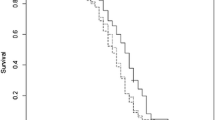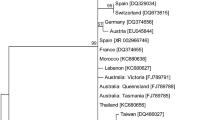Abstract
Nosema ceranae, a microsporidian formerly regarded as confined to its Asiatic host Apis cerana, has recently been shown to parasitise Apis mellifera and to have spread throughout most of the world in the past few years. Using a temporal sequence of N = 28 Nosema isolates from Finland from 1986–2006, we now find (i) that N. ceranae has been present in Europe since at least 1998 and (ii) that it has increased in frequency across this time period relative to Nosema apis, possibly leading to higher mean spore loads per bee. We then present results of a single laboratory infection experiment in which we directly compare the virulence of N. apis with N. ceranae. Though lacking replication, our results suggest (iii) that both parasites build up to equal numbers per bee by day 14 post infection but that (iv) N. ceranae induces significantly higher mortality relative to N. apis.
Zusammenfassung
Nosema ceranae, ein Microsporidien-Parasit der früher auf seinen asiatischen Wirt Apis cerana beschränkt war, ist kürzlich in Völkern von Apis mellifera nachgewiesen worden und hat sich in den vergangenen Jahren nahezu weltweit verbreitet. Wir untersuchten Nosema-Proben aus Finnland (N = 28), die in den Jahren 1986–2006 aus Bienen isoliert wurden (Abb. 1). Wir ermittelten die durchschnittliche Anzahl an Sporen pro Biene und bestimmten über PCR und Restriction Fragment Length Polymorphism (RFLP) des 16S rRNA-Gens auf der Parasiten-DNA die Nosema-Art. Wir konnten nachweisen, dass N. ceranae bereits seit mindestens 1998 in Finnland vorkommt, und dass seitdem der Anteil von N. ceranae im Vergleich zu N. apis zugenommen hat (Abb. 2). Dies hat möglicherweise zu einer insgesamt höheren Sporenbelastung pro Biene geführt (Abb. 3). Neuere Infektionen (2006) bestehen ausschließlich aus N. ceranae oder einer Mischinfektion von N. apis und N. ceranae.
Wir führten daraufhin ein einziges Laborexperiment durch, in dem wir die Virulenz von N. apis direkt mit der von N. ceranae verglichen. Dazu wurden Käfige mit jeweils 50 Bienen, die mit 105 Sporen von N. apis bzw. von N. ceranae gefüttert wurden, gefüllt. Die negative Kontrolle erhielt Zuckerwasser. Während der nächsten 15 Tage wurden die Anzahl der Sporen im Mitteldarm sowie die Mortalität der Bienen erfasst. Obwohl unsere Ergebnisse wegen der fehlenden Wiederholung nur vorläufigen Charakter haben, scheint bei beiden Parasiten die Anzahl der Sporen pro Biene während der ersten 14 Tage in ähnlichem Umfang zuzunehmen (Durchschnitt 27±2× 106 Sporen, Abb. 4). Allerdings verursachte N. ceranae eine signifikant höhere Bienenmortalität im Vergleich zu N. apis (Abb. 5). Wir diskutieren unsere Ergebnisse in Zusammenhang mit der beobachteten Zunahme an Völkerzusammenbrüchen in Südeuropa und wir beschreiben Experimente, die notwendig sind um den kausalen Zusammenhang zwischen N. ceranae-Infektionen und Völkerzusammenbrüchen nachzuweisen.
Similar content being viewed by others
References
Anderson D.L., Giacon H. (1992) Reduced pollen collection by honey-bee (Hymenoptera, Apidae) colonies infected with Nosema apis and sacbrood virus, J. Econ. Entomol. 85, 47–51.
Bailey L. (1981) Honey bee pathology, Academic Press, London.
Breguetova N.G. (1953) The mite fauna of the Far East, Parasitai. Zb. ZIN AN SSR 15, 302–338 [in Russian].
Cantwell G.E. (1970) Standard methods for counting Nosema spores, Am. Bee J. 110, 222–223.
Chen Y., Evans J.D., Smith I.B., Pettis J.S. (2007) Nosema ceranae is a long-present and wide-spread microsporidian infection of the European honey bee (Apis mellifera) in the United States, J. Invertebr. Pathol., in press (doi: 10.1016/j.jip.2007.08.005).
Fries I. (1988a) Comb replacement and Nosema disease (Nosema apis Z.) in honey bee colonies, Apidologie 19, 343–354.
Fries I. (1988b) Infectivity and multiplication of Nosema apis Z. in the ventriculus of the honey bee, Apidologie 19, 319–328.
Fries I. (1993) Nosema apis — a parasite in the honeybee colony, Bee World 74, 5–19.
Fries I. (1997) Protozoa, in: Morse R.A., Flottum K. (Eds.), Honey bee pests, predators and diseases, A.I. Root Company, Medina, Ohio, pp. 59–76.
Fries I., Ekbohm G., Villumstad E. (1984) Nosema apis, sampling techniques and honey yield, J. Apic. Res. 23, 102–105.
Fries I., Feng F., da Silva A., Slemenda S.B., Pieniazek N.J. (1996) Nosema ceranae n. sp. (Microspora, Nosematidae), morphological and molecular characterization of a microsporidian parasite of the Asian honey bee Apis cerana (Hymenoptera, Apidae), Eur. J. Protistol. 32, 356–365.
Fries I., Slemenda S.B., da Silva A., Pieniazek N.J. (2003) African honey bees (Apis mellifera scutellata) and nosema (Nosema apis) infections, J. Apic. Res. 42, 13–15.
Hatjina F., Haristos L. (2005) Project report to the prefecture of Chalkidiki on the situation of Varroa and Nosema infestation levels of honey bee colonies situated in the Paliouri area. Project funded by Hellenic Ministry of Agricultural Development and Food for 2004–2005, Hellenic Institute of Apiculture, Article 96/23-2-05, p. 8.
Hicheri L.K. (1978) Varroa jacobsoni in Africa, Apiacta 13, 178.
Higes M., Martín R., Sanz A., Álvarez N., Sanz A., García-Palencia P., Meana A. (2005) El síindrome de despoblamiento de las colmenas en España. Consideraciones sobre su origin, Vida Apíc. 133, 15–21.
Higes M., Martin R., Meana A. (2006) Nosema ceranae, a new microsporidian parasite in honeybees in Europe, J. Invertebr. Pathol. 92, 93–95.
Higes M., García-Palencia P., Martín-Hernández R., Meana A. (2007) Experimental infection of Apis mellifera honeybees with Nosema ceranae (Microsporidia), J. Invertebr. Pathol. 94, 211–217.
Hirt R.P., Logsdon J.M., Healy B., Dorey M.W., Doolittle W.E, Embley T.M. (1999) Microsporidia are related to fungi: evidence from the largest sub-unit of RNA polymerase II and other proteins, Proc. Natl. Acad. Sci. (USA) 96, 580–585.
Huang W.-F., Jiang J.-H., Chen Y.-W., Wang C.-H. (2007) A Nosema ceranae isolate from the honeybee Apis mellifera, Apidologie 38, 30–37.
Imdorf A., Charrière J.D., Gallmann P. (2006) Mögliche Ursachen für die Völkerverluste der letzten Jahre, Schweiz. Bienenztg. 129, 6–10.
Keeling P.J., McFadden G.I. (1998) Origins of microsporidia, Trends Microbiol. 6, 19–23.
Klee J., Tay W.T., Paxton R.J. (2006) Specific and sensitive detection of Nosema bombi (Microsporidia: Nosematidae) in bumble bees (Bombus spp.; Hymenoptera: Apidae) by PCR of partial rRNA gene sequences, J. Invertebr. Pathol. 91, 98–104.
Klee J., Besana A.M., Genersch E., Gisder S., Nanetti A., Tam D.Q., Chinh T.X., Puerta F., Kryger P., Message D., Hatjina F., Korpela S., Fries I., Paxton R.J. (2007) Widespread dispersal of the microsporidian Nosema ceranae, an emergent pathogen of the western honey bee, Apis mellifera, J. Invertebr. Pathol. 96, 1–10.
Korpela S. (1998) Pest status and incidence of the honey bee tracheal mite in Finland, Agric. Food Sci. Finland 7, 469–476.
Korpela S. (1999) Varroapunkin resistenssiä Apistanille Suomessa — haaste mehiläishoitajille, neuvonnalle ja tutkimukselle, Mehiläinen 16, 42–46.
Korpela S. (2002) Honey bee trachéal mite in Finland: population dynamics, natural transmis sion between apiaries and impacts of introductions via bee trade, in: Jones R. (Ed.), Bees without frontiers: proceedings of the 6th European bee conference in Cardiff 2002, IBRA, Cardiff, pp. 66–72.
Larsson J.I.R. (1986) Ultrastructure, function and classification of Microsporidia, Protistology 1, 325–390.
Lotmar R. (1943) Über den Einfluss der Temperatur auf den Parasiten Nosema apis, Beihefte Schweiz. Bienenztg. 1, 261–284.
O’Mahony E.M., Tay W.T., Paxton R.J. (2007) Multiple rRNA variants in a single spore of the microsporidian Nosema bombi, J. Eukaryot. Microbiol. 94, 103–109.
Rice W.R. (1989) Analyzing tables of statistical tests, Evolution 43, 223–225.
Samsinak K., Haragsim O. (1972) The mite Varroa jacobsoni imported into Europe, Vcelarstvi 25, 268–269 [in Czech].
Sanford M.T. (2001) Introduction, spread and economic impact of mites in North America, in: Mites of the honey bee, Dadant & Sons, Hamilton, Illinois, pp. 149–162.
Tay W.T., O’Mahony E.M., Paxton R.J. (2005) Complete rRNA gene sequence reveal that the microsporidium Nosema bombi infects diverse bumble bee (Bombus spp.) hosts, yet contains multiple polymorphic sites, J. Eukaryot. Microbiol. 55, 505–513.
Weiss L.M., Vossbrinck C.R. (1999) Molecular biology, molecular phylogeny, and molecular diagnostic approaches to the microsporidia, in: Wittner M., Weiss L.M. (Eds.), The Microsporidia and microsporidiosis., American Society for Microbiology, Washington DC, pp. 129–171.
Zander E. (1909) Tierische Parasiten als Krankheitserreger bei der Biene, Leipziger Bienenztg. 24, 147–150, 164–166.
Author information
Authors and Affiliations
Corresponding author
Additional information
Manuscript editor: Peter Rosenkranz
Rights and permissions
About this article
Cite this article
Paxton, R.J., Klee, J., Korpela, S. et al. Nosema ceranae has infected Apis mellifera in Europe since at least 1998 and may be more virulent than Nosema apis . Apidologie 38, 558–565 (2007). https://doi.org/10.1051/apido:2007037
Received:
Revised:
Accepted:
Issue Date:
DOI: https://doi.org/10.1051/apido:2007037




